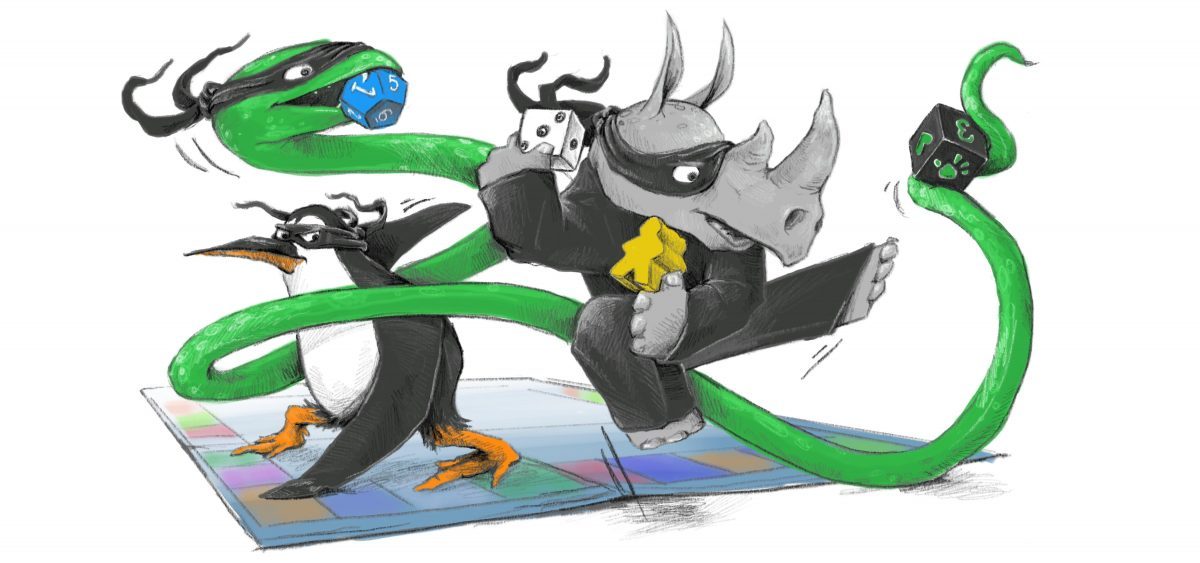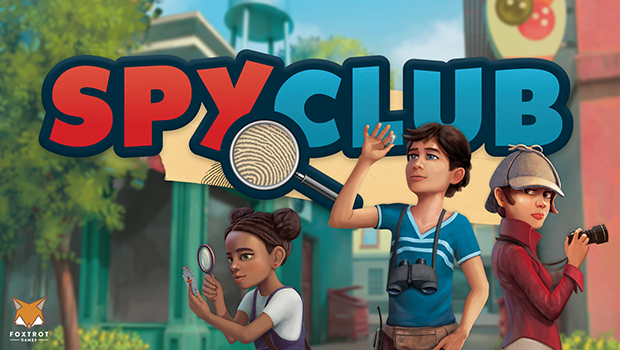So it’s time again for me to tell you about a game that I can’t tell you much about. And this time it’s for kids. We’ll, certainly not just for kids. It’s called Spy Club and I’ll tell you from the start that i adore it, but I’ll try not to gush too much.
In Spy Club, you play as a group of kids who are basically amateur detectives, and you have this funny feeling that something is going on in your town. You don’t exactly know what or who or where, but you’re going to find out. (It’s probably the Garbage Man!)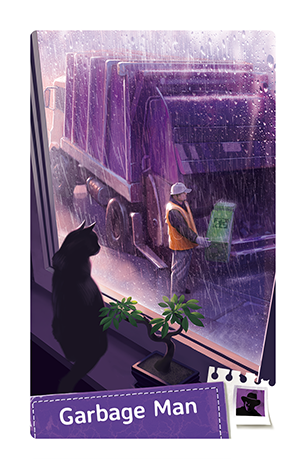
Spy Club is mostly made up of double sided large clue cards. Each side depicts a Suspect, Location, Object, Motive, Crime or Distraction. Each category of information is a different color, and the colors definitely matter. Your job is to, as a team, figure out each part of the Mystery over the course of 5 games. Each game you are going to be figuring out one part, for example the Location, and then moving on to solving another part. If you can solve one part each game, your going to win.
Each side depicts a Suspect, Location, Object, Motive, Crime or Distraction. Each category of information is a different color, and the colors definitely matter. Your job is to, as a team, figure out each part of the Mystery over the course of 5 games. Each game you are going to be figuring out one part, for example the Location, and then moving on to solving another part. If you can solve one part each game, your going to win.
But…there’s more. This game uses what they are calling the Mosaic system. Each time you solve a piece of the Crime, you unlock more information that changes the way you play the game. This new information may add a new way of gathering information or change the way you have to play your cards to win. Not quite a legacy game – more in the vein of Time Stories, but not linear either. There is never just one path to victory. So, it has lots of replayability and each time will be very different. It is very slick.
So…here’s what i can tell you (and keep in mind I’ve only played one full campaign at Gen Con, so I may mess a few things up):
You will start out with a number of cards set out in front of you, (I think it’s equal to the number of players). On your turn you have 3 actions to perform that will help the team solve part of the mystery. The possible actions are flipping cards, changing your focus, trading cards and committing cards. There are also other abilities and actions unlocked through the course of the campaign that change the way these actions work or how you will use them.
Flipping Cards: on your turn you can flip any number of cards on the table in front of you. Remember, the cards are double sided. Sometimes the cards will have a Red clue on one side and a Yellow on the other. You’re job is to remember what’s on the back of each so that you can manipulate the cards into a position that allows you to commit the right clues to the investigation at the right time. So basically flipping your cards allows you to get the colors in the right place for the next step.
Confirming cards: In order to complete the investigation of the parts of the Mystery, you must share the information with your fellow Spy Club members. You do this by committing cards to the center of the table. You are trying to commit 5 cards of the same color. Once you successfully do this, you move on to committing 5 cards of a different color and so on until you have solved all 5 colors and then the current game will be over. Sometimes you want to commit 2 cards or you only have one action left and your Magnifying glass is focused on a Blue Suspect card and your team is working on Locations. In this case you must spend 1 or 2 idea tokens in order to commit the card to the center. But, don’t worry you can get more ideas by shifting the focus of your investigation. On the other hand, there are also ways to lose ideas and have them removed from the game, and if you run out, you lose.
Changing your focus: All players have a magnifying glass token that allows them to focus on a certain aspect of the investigation. This is the part of the Mystery they are working on currently (the color). If they are focused on the Motive, then sending a Red Motive card to the center of the table by using the Confirming cards action is easier-you don’t have to spend an idea token.
Trading cards: If you and another player are both focused on the same Aspect of the Mystery (the same color), you can trade cards with each other for free. This often comes in handy when you are trying to commit 2 cards and finish up a color in the center.
So, no big deal right, we’ll just methodically solve this part of the mystery, then the next one and be home by dinner.
Not so fast.
You see, the Suspect is on the move and trying to cover their tracks. After every players turn, the Suspect will move. The suspect moves around the table landing on players’ different Clue cards. There is a Suspect movement card deck that tells you how many spaces the Suspect moves.  Where the Suspect lands matters quite a bit. Depending on the color of the card that the Suspect lands on, something bad happens.
Where the Suspect lands matters quite a bit. Depending on the color of the card that the Suspect lands on, something bad happens.
Sometimes the Suspect escapes 1 more space on the Suspect tracker, sometimes you are forced to give up one or more of your idea tokens, or flip all your cards, or lose Clue cards. Either way, it’s something that you will have to account for and make sure you are prepared for.
So, if you manage to commit all 5 cards for all 5 colors you win that game. If you run out of time, because the Suspect escapes or you run out of tokens before you solve all 5, you lose.
But losing isn’t all bad. You can still solve part of the Mystery even if you have lost. As long as you have solved one aspect, you can commit that solved part to the solution of the whole Mystery.
Sounds complicated? It’s not really.
Say our group commits enough cards to the table to solve the Blue cards and figure out the Suspect, the Neighbor. Then we run out of time. We can still say the Neighbor is the Suspect and start working on another part of the Mystery next game. That’s why it is important to work on a different part of the Mystery first the next game instead of the Suspect again.
So here’s where the game gets fun. Now that we have determined that they Neighbor is the Suspect, we look up in the Gamebook and follow all of the instructions listed with the Neighbor. (Kinda like Betrayal at House on the Hill) This can and will change the way we play the rest of the games in the Campaign. If we had determined that the suspect was the Twins, we would unlock different changes and play a completely different campaign.
So that’s kinda the basics – but what do we think? How does it play?
Basically…it’s incredible! I love this game. The design is intricate and very imaginative, and trust me one game is never enough. Each time you play the game it’s different, and each campaign will change as you are playing it. Each time you commit a card to the center of the table, you are changing the game. Each time you trade a card with another player, you are potentially changing the outcome of the Suspect’s movement.
Everything matters. You have to remember what is on the back sides of your cards. You have to change your focus to prepare for Confirming cards to the center of the table, and also to be set up for trades. You have to have enough ideas to spend and trade, and keep enough in play so that you can lose some to the Suspect.
The movement of the Suspect provides the tension that they game needs to make it really work. It moved the game forward, acts as a timer, and really gets the table talk going.
The cards themselves are gorgeous, and just the right size.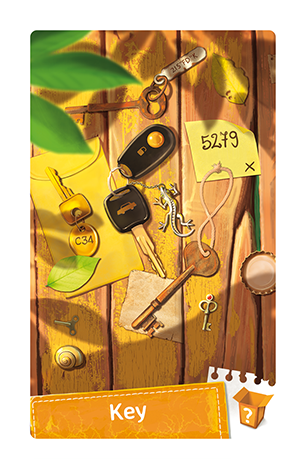
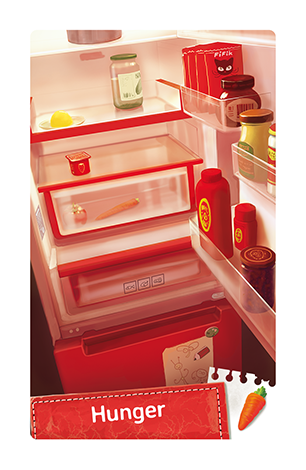 The movement deck for the Suspect is really well done and also solidifies parts of the Mystery for you.
The movement deck for the Suspect is really well done and also solidifies parts of the Mystery for you.
The Mosaic system allows for tons of replayability too. When we finished our 2:30 in the morning campaign at GenCon, I wanted to play more immediately (well, maybe the next day). And we could’ve played again and gotten none of the same aspects of the Mystery. And lest you think that this is just a kids game, it was 4 very experience game reviewers and game designers having a blast playing until late into the night.
I mean, there’s really nothing I don’t like about this game.
This is one of those games that you see, and you know immediately that you’re going to back it…and all of its expansions…and everything else by the designers…Just get the game – you won’t be disappointed. Ninja Approved!!!
